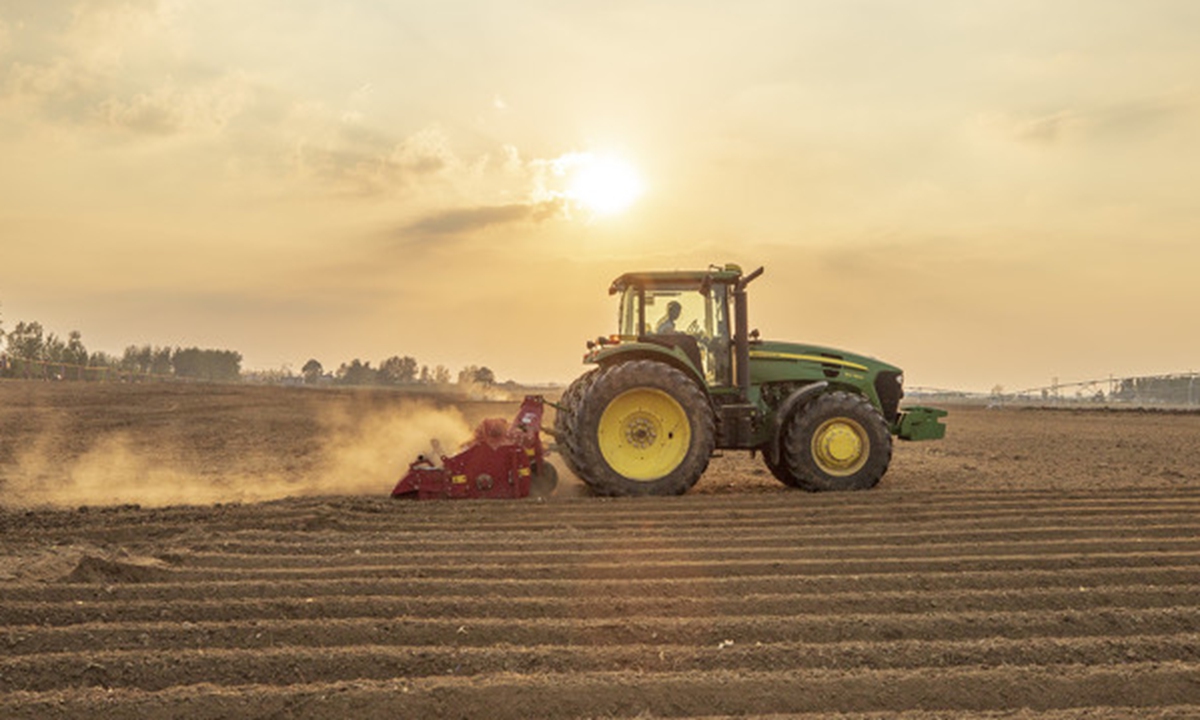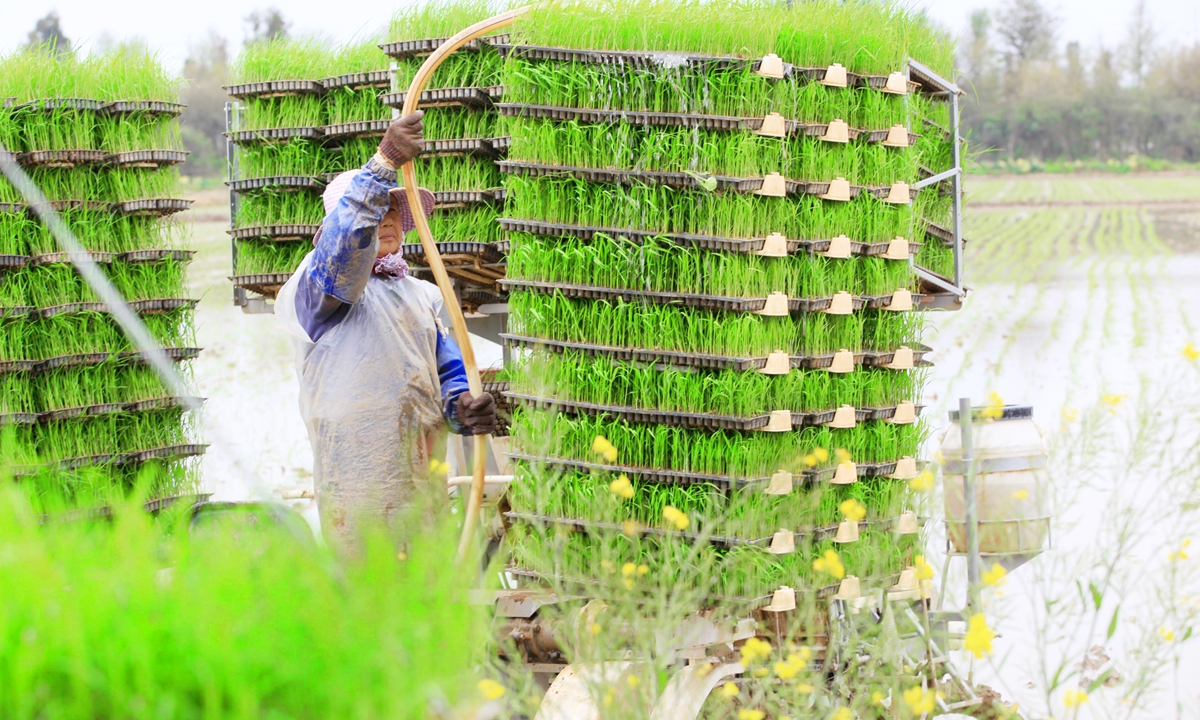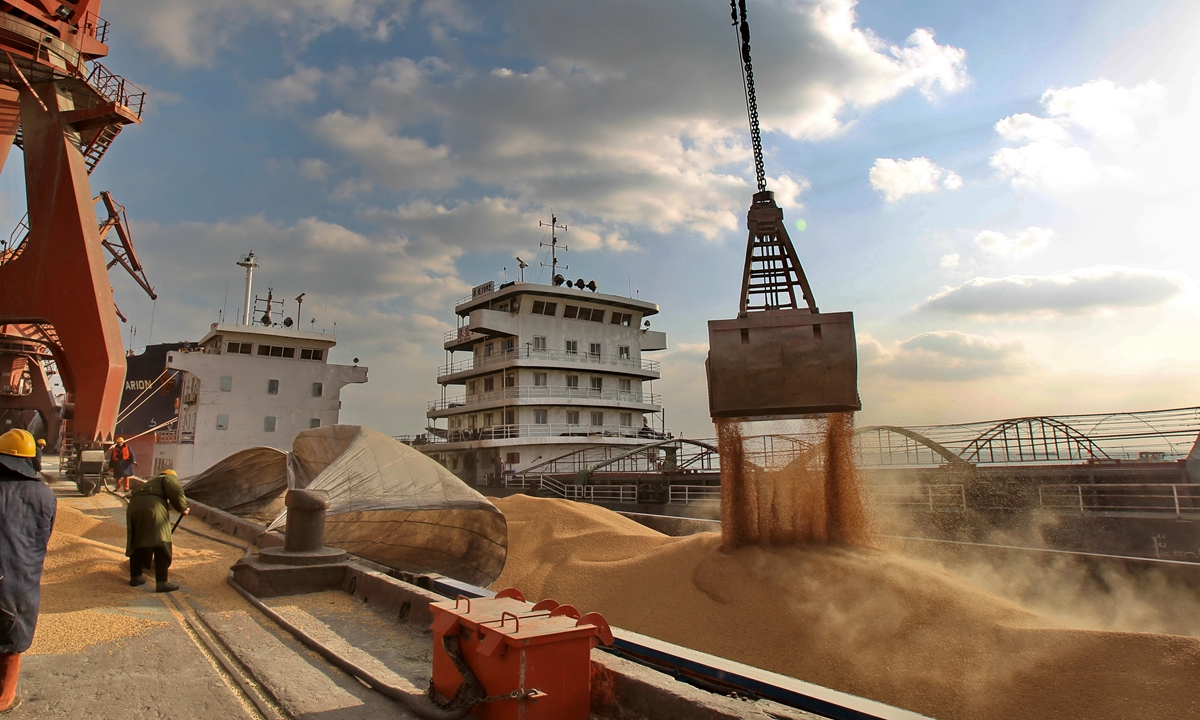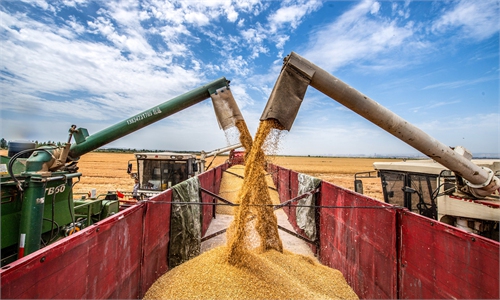IN-DEPTH / IN-DEPTH
National agro and reserve system, needs-based imports ensure food security for 1.4 billion
‘Chinese rice’ in ‘Chinese bowl’

Photo: VCG
Editor's Note:
As a country with a population of approximately 1.4 billion, China attaches great importance to food security.
The conflict between Russia and Ukraine has pushed up food and fertilizer prices, and some impacts on global grain supplies have been witnessed. Though China has assured its food security, some foreign media outlets took this opportunity to falsely claim that China will face grain shortages, to stoke anxiety and blame China for the tension in Ukraine.
Who is hyping China's supposed food issue? Are China's grain production and supplies safe enough? How will China guarantee its food supply? The Global Times will present three investigative reports in the coming days. This is the second installment.
The conflict between Russia and Ukraine, with the two nations accounting for about a quarter of the world's grain trade, is now spurring fears of a potential food crisis internationally; China, meanwhile, has reassured its citizens and international observers that it's able to feed nearly 20 percent of the world's population - a huge relief to the global food system - thanks to the central government's early agro-layout, a well-established national reserve system, as well as a top to bottom emergency mechanism.
The building up of this mechanism comes from the central government's decades-long focus on food security - with policies regarding agriculture and rural areas high on the agenda - promoting the construction of the world's largest grain reserves and a well-established emergency response system.
Chinese experts and farmers also told the Global Times that as the Ukraine crisis erupted just at the start of China's busy spring farming season, strenuous efforts nationwide have been made recently to guarantee another bumper harvest amid challenges from a domestic epidemic resurgence and mounting external uncertainties.
Ukraine and Russia are enormous producers of wheat, corn, barley, sunflower oil, and fertilizer. According to industry calculations, Russia and Ukraine account for 29 percent of the world's wheat exports and together they account for 19 percent of the global corn output and 80 percent of the world's sunflower oil production.
Russia is also one of the world's largest fertilizer exporters. Since fertilizer costs typically account for 33 to 44 percent of grain growers' total operating costs, higher fertilizer prices will further affect production in other major agrarian countries.
"There's a high possibility that there would be a world food crisis," said Xu Poling, director of the Russian Economic Office at the Institute of East European, Russian, and Central Asian Studies under the Chinese Academy of Social Sciences, warning that the dwindling supply could pose more threats to low-income countries, such as those in Africa.
Since ongoing tensions also disrupt Ukraine's spring crop sowing, the impact may become more apparent in Autumn this year, Xu told the Global Times.
The World Food Programme (WFP) Executive Director David Beasley said in March that the impact of a food shortage "is not just dynamically decimating Ukraine and the region, but it will have [a] global context impact beyond anything we've seen since World War Two."
The UN food chief also warned that the crisis was compounded by a lack of fertilizer coming from Belarus and Russia.
"If you don't put fertilizer on the crops, your yield will be at least 50 percent diminished. So we're looking at what could be a catastrophe on top of a catastrophe in the months ahead," said the UN official.

A farmer waters rice seedlings in Taizhou, East China's Zhejiang Province. Photo: VCG
Staples 'fully secured'
While the escalating situation could engulf the world in a potential food crisis, Li Xinhai, director of the Institute of Biology under the Academy of Agricultural Science, stressed that the storm is unlikely to threaten food security in China.
"The impact on China is quite limited," Li said.
In 2021, China's imports of soybeans, wheat, corn, and barley from Russia accounted for less than 1 percent of total imports; corn imported from Ukraine accounted for 29 percent of total annual imports, while barley imports stood at 26 percent, and among these imports, a considerable portion is used as animal feed, customs data showed.
The inventory also remains high, backing the country in coping with any external risks.
"At present, China's wheat inventory is at a historically high level, which can meet domestic consumption demand for more than a year," Sun Heng, a wheat analyst at the National Grain and Oil Information Center, told the Global Times.
Sun noted that China's wheat is fully self-sufficient, and allowing for a small percentage of wheat imports is mainly for variety adjustment to meet the improvement of people's living standards.
Industry players told the Global Times that China has also stockpiled staples such as corn, sorghum, and wheat in the past two years - when prices were relatively affordable - as part of efforts to prioritize national agricultural safety.
A mature food supply network also helps ensure the country's preparedness for emergency use. So far, there are 5,507 grain and oil emergency processing firms and 45,939 emergency supply networks across the nation, Qin Yuyun, an official at the National Food and Strategic Reserves Administration, revealed in March.
In addition to sufficient unprocessed grain reserves, the 36 large and medium-sized cities and areas currently experiencing volatile markets all have an inventory of processed grain and oil products to last more than 20 days, Qin said.
"No matter how the external situation changes, we are capable of ensuring that more than 1.4 billion people have each meal on time. Our rice bowls will be held more firmly in our own hands and filled with better and healthier food," Tang Renjian, minister of agriculture and rural affairs, said in March.
Moreover, while warning about a possible spillover effect of a price hike from the global market, analysts said the impact will not be "too much" with the country's state grain auction system - which can effectively balance domestic market demand and supply, and food price when global food prices soar.
The whole system can enable China to feed its 1.4 billion people, forming a closed-loop supply system even when import channels are closed for whatever reason, Xu said.

Imported soybeans are loaded at the port of Nantong, East China's Jiangsu Province. Photo: VCG
Dynamic crop planting
Although the absolute safety of staples can be ensured, with only 9 percent of the world's arable land, China still depends on the importation of certain kinds of farm products, for instance, soybeans, palm oil, and rapeseed oil, of which policymakers have been striving to address over recent years.
With a self-sufficiency rate of less than 20 percent, soybeans are one of the few grains for which China relies heavily on imports. Major sources of imports are the US, Brazil, and Argentina. Expanding the domestic production of soybeans and oil crops has been seen as a policy focus in an effort to reduce the country's dependence on imports.
Chinese authorities launched multiple measures this year to increase the production capacity of soybeans and other oilseeds, including improving subsidy mechanisms for soybean farmers, actively guiding farmers in Northeast China - the main production base - to expand soybean cultivation areas, and encouraging firms to actively engage in the research and development of new technological breakthroughs.
"We've made breakthrough progress in tackling the bottleneck problem in biological soybean breeding, and have cultivated more than 200 new biological corn varieties to continuously meet the country's food security demand," a spokesperson for the Beijing-based leading agricultural firm Da Bei Nong (DBN) Group, told the Global Times.
"Our farm is testing and promoting the soybean-corn multicropping agricultural technology under the guidance of the local authority, to boost soybean production," Zhang Bo, a farmer in Northeast China's Heilongjiang Province, told the Global Times, adding that subsidies are a great incentive for farmers to expand planting areas for soybeans.
Zhang explained that soybean-corn multicropping refers to planting two lines of corn and four lines of soybean on farmland that ensures a stable corn and soybean output.
As the country's largest soybean production base, Heilongjiang sees its soybean planting area accounting for more than 40 percent of China's total. Local agricultural authorities have recommended 23 new superior soybean varieties for growers over the years, helping boost yields.
In addition, with more policy support to encourage sowing, it is estimated that China's soybean planting area will increase by more than 20 million mu (1.33 million hectares) in 2022 from 2021 and exceed the 2020 total, given stable weather conditions, Wang Liaowei, a senior economist from the National Grain and Oil Information Center, told the Global Times.
"But it's worth noting that with such a huge consumption demand, achieving self-sufficiency in soybean production and shaking off foreign reliance might still need time," Xu suggested.
In 2021, China imported more than 90 million tons of soybeans, and was the world's largest importer, while the volume in 2020 was over 100 million tons, customs data showed. Imported soybeans are used in making edible oil and animal feed protein.
As April marks the start of China's busy spring farming season, the first major effort to ensure sufficient grain production for the whole year, spring farming is in full swing across the country, despite challenges posed by COVID-19 and other factors.
Officials in Northeast China's Jilin Province, the main production base, said on Tuesday that the province is "making every effort" to ensure that stranded farmers can return to their hometowns to commence spring farming, and supplies of seeds and fertilizers can reach the fields in time.
China has set a target to ensure the year-round grain output stays above 650 billion kilograms in 2022. In 2021, China's grain output hit a new high of 683 billion kilograms, with grain farmland exceeding 117 million hectares.
A priority policy, stable supply, and well-established grain mechanisms, jointly guarded China's grain system against any external risks, Xu said, noting that feeding the world's largest population itself is also a contribution to a world that's challenged by a disrupted grain supply chain.
Next up:
China's seeds security not threatened by overseas market volatility; breakthroughs made in 'bottleneck' corn and soybean cultivation

